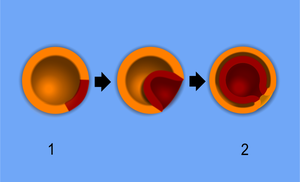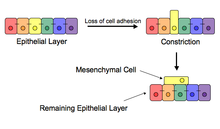- Gastrulation
-
 Gastrulation of a diploblast: The formation of germ layers from a (1) blastula to a (2) gastrula. Some of the ectoderm cells (orange) move inward forming the endoderm (red).
Gastrulation of a diploblast: The formation of germ layers from a (1) blastula to a (2) gastrula. Some of the ectoderm cells (orange) move inward forming the endoderm (red).
Gastrulation is a phase early in the embryonic development of most animals, during which the single-layered blastula is reorganized into a trilaminar ("three-layered") structure known as the gastrula. These three germ layers are known as the ectoderm, mesoderm, and endoderm.[1][2]
Gastrulation takes place after cleavage and the formation of the blastula and primitive streak. Gastrulation is followed by organogenesis, when individual organs develop within the newly formed germ layers.[3] Each layer gives rise to specific tissues and organs in the developing embryo. The ectoderm gives rise to epidermis, and to the neural crest and other tissues that will later form the nervous system. The mesoderm is found between the ectoderm and the endoderm and gives rise to somites, which form muscle; the cartilage of the ribs and vertebrae; the dermis, the notochord, blood and blood vessels, bone, and connective tissue. The endoderm gives rise to the epithelium of the digestive system and respiratory system, and organs associated with the digestive system, such as the liver and pancreas.[4] Following gastrulation, cells in the body are either organized into sheets of connected cells (as in epithelia), or as a mesh of isolated cells, such as mesenchyme.[2][5]
The molecular mechanism and timing of gastrulation is different in different organisms. However some common features of gastrulation across triploblastic organisms include: (1) A change in the topological structure of the embryo, from a simply connected surface (sphere-like), to a non-simply connected surface (torus-like); (2) the differentiation of cells into one of three types (endodermal, mesodermal, and ectodermal); and (3) the digestive function of a large number of endodermal cells.[6]
Lewis Wolpert, pioneering developmental biologist in the field, has been credited for noting that "It is not birth, marriage, or death, but gastrulation, which is truly the most important time in your life."
The terms "gastrula" and "gastrulation" were coined by Ernst Haeckel, in his 1872 work "Biology of Calcareous Sponges".[7]
Contents
In amniotes
Overview
In amniotes, gastrulation occurs in the following sequence: (1) the embryo becomes asymmetric; (2) the primitive streak forms; (3) cells from the epiblast at the primitive streak undergo an epithelial to mesenchymal transition and ingress to at the primitive streak to form the germ layers.[4]
Loss of Symmetry
In preparation for gastrulation, the embryo must become asymmetric along both the proximal-distal axis and the anterior-posterior axis. The proximal-distal axis is formed when the cells of the embryo form the “egg cylinder,” which consists of the extraembryonic tissues, which give rise to structures like the placenta, at the proximal end and the epiblast at the distal end. Many signaling pathways contribute to this reorganization, including BMP, FGF, nodal, and Wnt. Visceral endoderm surrounds the epiblast. The distal visceral endoderm (DVE) migrates to the anterior portion of the embryo, forming the “anterior visceral endoderm” (AVE). This breaks anterior-posterior symmetry and is regulated by nodal signaling.[4]
Formation of the Primitive Streak
The primitive streak is formed at the beginning of gastrulation and is found at the junction between the extraembryonic tissue and the epiblast on the posterior side of the embryo and the site of ingression.[8] Formation of the primitive streak is reliant upon nodal signaling[4] within the cells contributing to the primitive streak and BMP4 signaling from the extraembryonic tissue.[8][9] Furthermore, Cer1 and Lefty1 restrict the primitive streak to the appropriate location by antagonizing nodal signaling.[10] The region defined as the primitive streak continues to grow towards the distal tip.[4]
During the early stages of development, the primitive streak is the structure that will establish bilateral symmetry, determine the site of gastrulation and initiate germ layer formation. To form the streak, reptiles, birds and mammals arrange mesenchymal cells along the prospective midline, establishing the first embryonic axis, as well as the place where cells will ingress and migrate during the process of gastrulation and germ layer formation.[11] The primitive streak, extends through this midline and creates the antero-posterior body axis,[12] becoming the first symmetry-breaking event in the embryo, and marks the beginning of gastrulation.[13] This process involves the ingression of mesoderm and endoderm progenitors and their migration to their ultimate position,[12][14] where they will differentiate into the three germ layers.[11]
Epithelial to Mesenchymal Transition and Ingression
In order for the cells to move from the epithelium of the epiblast through the primitive streak to form a new layer, the cells must undergo an epithelial to mesenchymal transition (EMT) to lose their epithelial characteristics, such as cell-cell adhesion. FGF signaling is necessary for proper EMT. FGFR1 is needed for the up regulation of Snail1, which down regulates E-cadherin, causing a loss of cell adhesion. Following the EMT, the cells ingress through the primitive streak and spread out to form a new layer of cells or join existing layers. FGF8 is implicated in the process of this dispersal from the primitive streak.[10]
See also
- Fate map
- Henson's Node[15]
- Neurulation
- Vegetal rotation
References
Notes
- ^ Mundlos, Stefan (2009). "Gene action: developmental genetics". In Speicher, Michael et al.. Vogel and Motulsky's Human Genetics: Problems and Approaches (4th ed.). Springer. p. 422. ISBN 9783540376538. http://books.google.com/books?id=FlfPSpBvKLgC&pg=PA422.
- ^ a b McGeady, 2004: p. 34
- ^ Hall, 1998: pp. 132-134
- ^ a b c d e Arnold, S.J. & Robertson, E.J. (2009). "Making a commitment: cell lineage allocation and axis patterning in the early mouse embryo". Nat Rev Mol Cell Biol 10 (2): 91–103. doi:10.1042/BST2005152610.1038/nrm2618. PMID 19129791.
- ^ Hall, 1998: p. 177
- ^ Harrison, Lionel G. (2011). The Shaping of Life: The Generation of Biological Pattern. Cambridge University Press. p. 206. ISBN 9780521553506. http://books.google.com/books?id=-IPG-vg7Pr8C&pg=PA206.
- ^ Ereskovsky, Alexander V. (2010). The Comparative Embryology of Sponges. Springer. p. 236. ISBN 9789048185740. http://books.google.com/books?id=PHztG3LEUnsC&pg=PA236.
- ^ a b Tam, P.L. & Behringer, R.R. (1997). "Mouse gastrulation: the formation of a mammalian body plan". Mech Dev 68 (1-2): 3–25. doi:10.1016/S0925-4773(97)00123-8. PMID 9431800.
- ^ Catala, M. (2005). "Cell Movements During Gastrulation". In Tortori-Donati, Paolo et al.. Pediatric Neuroradiology: Brain. Springer. p. 1535. ISBN 9783540410775. http://books.google.com/books?id=RJvkR3gfExwC&pg=PA1535.
- ^ a b Tam, P.P. & Loebel, D.A (2007). "Gene function in mouse embryogenesis: get set for gastrulation". Nat Rev Genet 8 (5): 368–81. doi:10.1038/nrg2084. PMID 17387317.
- ^ a b Mikawa T, Poh AM, Kelly KA, Ishii Y, Reese DE. (2004). "Induction and patterning of the primitive streak, an organizing center of gastrulation in the amniote.". Dev Dyn 229 (3): 422–32. doi:10.1002/dvdy.10458. PMID 14991697.
- ^ a b Downs KM. (2009). "The enigmatic primitive streak: prevailing notions and challenges concerning the body axis of mammals.". Bioessays 31 (8): 892–902. doi:10.1002/bies.200900038. PMC 2949267. PMID 19609969. http://www.pubmedcentral.nih.gov/articlerender.fcgi?tool=pmcentrez&artid=2949267.
- ^ Chuai M, Zeng W, Yang X, Boychenko V, Glazier JA, Weijer CJ. (2006). "Cell movement during chick primitive streak formation.". Dev Biol. 296(1)) (1): 137–49.. doi:10.1016/j.ydbio.2006.04.451. PMC 2556955. PMID 16725136. http://www.pubmedcentral.nih.gov/articlerender.fcgi?tool=pmcentrez&artid=2556955.
- ^ Chuai M, Weijer CJ. (2008). "The mechanisms underlying primitive streak formation in the chick embryo.". Curr Top Dev Biol. 81: 135–56.. doi:10.1016/S0070-2153(07)81004-0. PMID 18023726.
- ^ See
Bibliography
- Hall, Brian Keith (1998). Evolutionary developmental biology. Birkhäuser. ISBN 9780412785801. http://books.google.com/books?id=JhSwumfgTQ4C.
- McGeady, Thomas A., ed (2006). "Gastrulation". Veterinary embryology. Wiley-Blackwell. ISBN 9781405111478. http://books.google.com/books?id=n4C0TUeR7mUC&pg=PA34.
Further reading
- Baron, Margaret H. (2001). "Embryonic Induction of Mammalian Hematopoiesis and Vasculogenesis". In Zon, Leonard I.. Hematopoiesis: a developmental approach. Oxford University Press. ISBN 9780195124507. http://books.google.com/books?id=zolYg-SsVhQC&pg=PA162.
- Cullen, K.E. (2009). "embryology and early animal development". Encyclopedia of life science, Volume 2. Infobase. ISBN 9780816070084. http://books.google.com/books?id=iM_O62qBSQYC&pg=PA283.
- Forgács, G. & Newman, Stuart A. (2005). "Cleavage and blastula formation". Biological physics of the developing embryo. Cambridge University Press. ISBN 9780521783378. http://books.google.com/books?id=rUyVWQhk7CkC&pg=PA24.
- Forgács, G. & Newman, Stuart A. (2005). "Epithelial morphogenesis: gastrulation and neurulation". Biological physics of the developing embryo. Cambridge University Press. ISBN 9780521783378. http://books.google.com/books?id=rUyVWQhk7CkC&pg=PA99.
- Hart, Nathan H. & Fluck, Richard A. (1995). "Epiboly and Gastrulation". In Capco, David. Cytoskeletal mechanisms during animal development. Academic Press. ISBN 9780121531317. http://books.google.com/books?id=v2lAYAEZrgsC&pg=PA362.
- Knust, Elizabeth (1999). "Gastrulation movements". In Birchmeier, Walter & Birchmeier, Carmen. Epithelial Morphogenesis in Development and Disease. CRC Press. pp. 152–153. ISBN 9789057024191. http://books.google.com/books?id=auK62QPZOWkC&pg=PA152.
- Kunz, Yvette W. (2004). "Gastrulation". Developmental biology of Teleost fishes. Springer. ISBN 9781402029967. http://books.google.com/books?id=BWsrvViQmw0C&pg=PA207.
- Nation, James L., ed (2009). "Gastrulation". Insect physiology and biochemistry. CRC Press. ISBN 9780849311819. http://books.google.com/books?id=l3v2tOvz1uQC&pg=PA9.
- Ross, Lawrence M. & Lamperti, Edward D., ed (2006). "Human Ontogeny: Gastrulation, Neurulation, and Somite Formation". Atlas of anatomy: general anatomy and musculoskeletal system. Thieme. ISBN 9783131420817. http://books.google.com/books?id=NK9TgTaGt6UC&pg=PA6.
- Sanes, Dan H. et al. (2006). "Early embryology of metazoans". Development of the nervous system (2nd ed.). Academic Press. pp. 1–2. ISBN 9780126186215. http://books.google.com/books?id=7q1XsiiIeNwC&pg=PA3.
- Stanger, Ben Z. & Melton, Douglas A. (2004). "Development of Endodermal Derivatives in the Lungs, Liver, Pancreas, and Gut". In Epstein, Charles J. et al.. Inborn errors of development: the molecular basis of clinical disorders of morphogenesis. Oxford University Press. ISBN 9780195145021. http://books.google.com/books?id=wGoj9RtTcVIC&pg=PA182.
External links
- Gastrulation Animations
- Gastrulation illustrations and movies from Gastrulation: From Cells To Embryo edited by Claudio Stern
Developmental biology > Human embryogenesis (development of embryo) and development of fetus (TE E2.0) First three
weeksWeek 1Fertilization · Oocyte activation · Zygote · Cleavage · Morula · Blastula (Blastomere) · Blastocyst · Inner cell massWeek 2
(Bilaminar)Week 3
(Trilaminar)Archenteron/Primitive streak (Primitive pit, Primitive knot/Blastopore, Primitive groove) · Gastrula/Gastrulation · Regional specification · Embryonic discSplanchnopleuric mesenchymeChorda- · Paraxial (Somite/Somitomere) · Intermediate · Lateral plate (Intraembryonic coelom, Splanchnopleuric mesenchyme/Somatopleuric mesenchyme)Categories:
Wikimedia Foundation. 2010.

